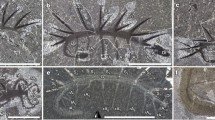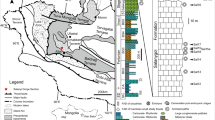Abstract
There has been a century-long debate in evolutionary developmental biology about whether the ancestral metazoan was a larva or an adult. Two competing hypotheses have been proposed: the “terminal addition” theory, which assumes the primitiveness of larvae, and the “intercalation” theory, which assumes the primitiveness of adults. A consensus has not yet been reached, but the “terminal addition” theory appears to be more widely accepted. However, in contrast to the majority of larvae among living metazoans, all currently known fossil invertebrate embryos such as Markuelia and Olivooides are direct developers. Here, we describe Eolarva kuanchuanpuensis gen. et sp. nov., the oldest known larva, from the early Cambrian (~535 Ma) of South China. Eolarva kuanchuanpuensis lacks a mouth or any other type of feeding apparatus, which is non-feeding or lecithotrophic. It possesses a distinct body plan and might represent a cnidarian-grade animal. This is the first fossil evidence indicating that indirect development is the plesiomorphy of metazoan development.
摘要
绝大多数现生海洋无脊椎动物的个体发育都有幼虫阶段,因而,生物学家认为间接发育是后生动物发育的原始特征。然而,由于已知的化石胚胎都是直接发育的,古生物学家认为直接发育才是后生动物发育的原始特征。本文报道了距今5.35亿年的化石幼虫——宽川铺始祖幼虫。此幼虫缺乏摄食器官,是不摄食或蛋黄营养型的。它展示了独特的体构,可能代表刺胞级的动物。据此,本文首次提供了间接发育是后生动物发育原始特征的化石证据。




Similar content being viewed by others
References
Haeckel E (1874) Die Gastrea-Theorie, die phylogenetische clasification des thierreichs und die homologie der keimblatter. Jena Z Naturw 8:1–55
Jägersten G (1972) The Evolution of Metazoan Life Cycle. Academic Press, London
Nielsen C (2013) Life cycle evolution: Was the eumetazoan ancestor a holopelagic, planktotrophic gastraea? BMC Evol Biol 13:171
Peterson KJ (2005) Macroevolutionary interplay between planktic larvae and benthic predators. Geology 33:929–932
Dong X-P, Bengtson S, Gostling NJ et al (2010) The anatomy, taphonomy, taxonomy and systematic affinity of Markuelia: Early Cambrian to Early Ordovician scalidophorans. Palaeontology 53:1291–1314
Bengtson S, Yue Z (1997) Fossilized metazoan embryos from the earliest Cambrian. Science 277:1645–1648
Conway Morris S (1998) Eggs and embryos from the Cambrian. BioEssays 20:676–682
Chen F, Dong X-P (2008) The internal structure of early Cambrian fossil embryo Olivooides revealed in the light of Synchrotron X-ray tomographic microscopy. Chin Sci Bull 53:3860–3865
Steiner M, Li G, Qian Y et al (2004) Lower Cambrian small shelly fossils of northern Sichuan and southern Shaanxi (China), and their biostratigraphic importance. Geobios 37:259–275
Peng S, Babcock LE, Cooper RA (2012) The Cambrian Period. In: Gradstein FM, Ogg JG, Schmitz M et al (eds) Geological Time Scale 2012. Elsevier, Oxford, pp 437–488
Steiner M, Qian Y, Li G et al (2014) The developmental cycles of early Cambrian Olivooidae fam. nov. (?Cycloneuralia) from the Yangtze Platform (China). Palaeogeogr Palaeoclimatol Palaeoecol 398:97–124
Ou Q, Xiao S, Han J et al (2015) A vanished history of skeletonization in Cambrian comb jellies. Sci Adv. doi:10.1126/sciadv.1500092
Müller KJ, Hinz-Schallreuter I (1993) Palaeoscolecid worms from the Middle Cambrian of Australia. Palaeontology 36:549–592
Harvey THP, Dong X-P, Donoghue PCJ (2010) Are palaeoscolecids ancestral ecdysozoans? Evol Dev 12:177–200
Duan B, Dong X-P, Donoghue PCJ (2012) New palaeoscolecid worms from the Furongian (upper Cambrian) of Hunan, South China: Is Markuelia an embryonic palaeoscolecid? Palaeontology 55:613–622
Dong X-P, Cunningham JA, Bengtson S et al (2013) Embryos, polyps and medusae of the early Cambrian scyphozoan Olivooides. Proc R Soc B (Biol Sci). doi:10.1098/rspb.2013.0071
Liu Y, Li Y, Shao T et al (2014) Quadrapyrgites from the lower Cambrian of South China: growth pattern, post-embryonic development, and affinity. Chin Sci Bull 59:4086–4095
Li P, Hua H, Zhang L et al (2007) Lower Cambrian phosphatized Punctatus from southern Shaanxi and their ontogeny sequence. Chin Sci Bull 52:2820–2828
Shao T, Liu Y, Wang Q et al (2015) New material of the oldest known scalidophoran animal Eopriapulites sphinx. Palaeoworld. doi:10.1016/j.palwor.2015.1007.1003
Raff RA (2008) Origins of the other metazoan body plans: The evolution of larval forms. Phil Trans R Soc B 363:1473–1479
Nielsen C (2012) Animal evolution: Interrelationships of the living phyla. Oxford University Press, Oxford
Thorson G (1950) Reproductive and larval ecology of marine bottom invertebrates. Biol Rev Camb Philos Soc 25:1–45
Davidson EH, Peterson KJ, Cameron RA (1995) Origin of bilaterian body plans: Evolution of developmental regulatory mechanisms. Science 270:1319–1325
Peterson KJ, Cameron RA, Davidson EH (1997) Set-aside cells in maximal indirect development: Evolutionary and developmental significance. BioEssays 19:623–631
Blackstone NW, Ellison AM (2000) Maximal indirect development, set-aside cells, and levels of selection. J Exp Zool 288:99–104
Nielsen C (2008) Six major steps in animal evolution: Are we derived sponge larvae? Evol Dev 10:241–257
Nielsen C (2015) Larval nervous systems: True larval and precocious adult. J Exp Biol 218:629–636
Brusca RC, Brusca GJ (2003) Invertebrates. Sinauer Associates, Inc. Publishers, Sunderland
Nielsen C (1985) Animal phylogeny in the light of the trochaea theory. Biol J Linn Soc 25:243–299
Strathmann RR, Jahn TL, Fonseca JC (1972) Suspension feeding by marine invertebrate larvae: Clearance of particles by ciliated bands of a rotifer, pluteus, and trochophore. Biol Bull 142:505–519
Wolpert L (1999) From egg to adult to larva. Evol Dev 1:3–4
Nielsen C, Nørrevang A (1985) The trochaea theory: An example of life cycle phylogeny. In: Conway Morris S, George JD, Gibson R et al (eds) The origins and relationships of lower invertebrates—(The Systematics Association, special volume No 28). Oxford University Press, Oxford, pp 28–41
Sly BJ, Snoke MS, Raff RA (2003) Who came first—Larvae or adults? Origins of bilaterian metazoan larvae. Int J Dev Biol 47:623–632
Valentine JW, Collins AG (2000) The significance of moulting in Ecdysozoan evolution. Evol Dev 2:152–156
Degnan SM, Degnan BM (2006) The origin of the pelagobenthic metazoan life cycle: What’s sex got to do with it? Integr Comp Biol 46:683–690
Minelli A (2009) Perspectives in Animal Phylogeny & Evolution. Oxford University Press Inc., New York
Maas A, Waloszek D, Haug JT et al (2009) Loricate larvae (Scalidophora) from the Middle Cambrian of Australia. Mem Assoc Aust Palaeontol 37:281–302
Maas A, Waloszek D, Haug JT et al (2007) A possible larval roundworm from the Cambrian “Orsten” and its bearing on the phylogeny of Cycloneuralia. Mem Assoc Aust Palaeontol 34:499–519
Wills MA, Gerber S, Ruta M et al (2012) The disparity of priapulid, archaeopriapulid and palaeoscolecid worms in the light of new data. J Evol Biol 25:2056–2076
Han J, Kubota S, Li G et al (2015) Divergent evolution of medusozoan symmetric patterns: Evidence from the microanatomy of Cambrian tetramerous cubozoans from South China. Gondwana Res. doi:10.1016/j.gr.2015.1001.1003
Acknowledgements
This work was supported by the National Natural Science Foundation of China (41372015, 41102003, J1210006), the State Key Laboratory of Palaeobiology and Stratigraphy, Nanjing Institute of Geology and Palaeontology, Chinese Academy of Sciences (103102, 20132107), and the Research Fund for the Doctoral Program of High Education (20060001059). We thank Shuhai Xiao for discussion and suggestions, Dinghua Yang for technical help, and two anonymous reviewers for their constructive comments.
Author information
Authors and Affiliations
Corresponding author
Ethics declarations
Conflict of interest
The authors declare that they have no conflicts of interest.
About this article
Cite this article
Zhang, H., Dong, XP. The oldest known larva and its implications for the plesiomorphy of metazoan development. Sci. Bull. 60, 1947–1953 (2015). https://doi.org/10.1007/s11434-015-0886-9
Received:
Accepted:
Published:
Issue Date:
DOI: https://doi.org/10.1007/s11434-015-0886-9




